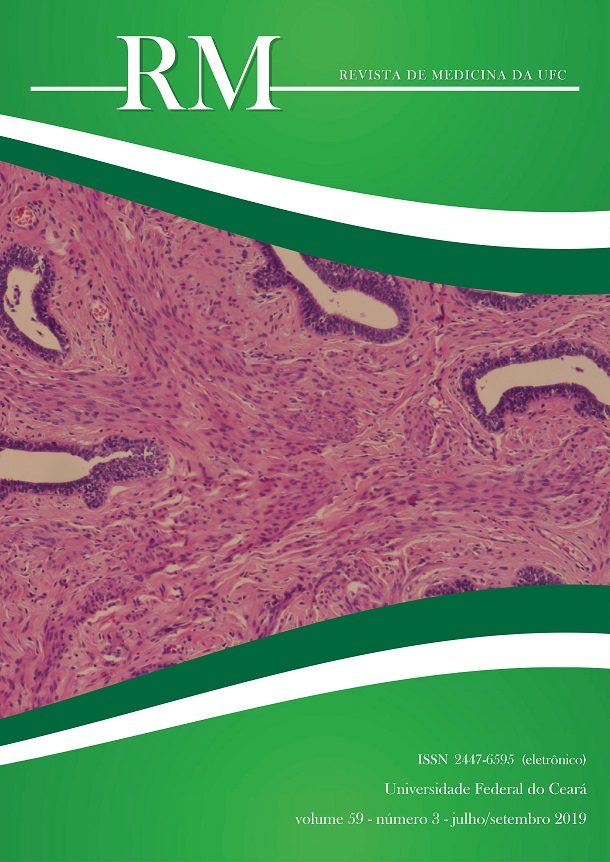Pycnogenol® (bark extract from pinus pinaster) uses in prevention and treatment of cardiopathies
DOI:
https://doi.org/10.20513/2447-6595.2019v59n3p44-47Schlagworte:
Pinus, Heart diseases, AntioxidantsAbstract
Pycnogenol® (Pyc) is an extract from a plant bark known as Pinus pinaster. Some studies have shown that Pyc can prevent oxidative damage, inhibit inflammatory cytokines and be used in the treatment of metabolic syndrome. This study aimed to review the state of the art of Pyc in the treatment of cardiovascular disease. The keywords “pycnogenol” and “cardiopathy” were searched on the PubMed, Scopus, The Cochrane Library, Scielo and Bireme databases. Studies involving animals or with no relation to cardiological conditions were excluded. The findings in the literature point Pycnogenol® as a promising substance in the treatment of cardiovascular conditions, as well as in other medical situations. Some studies have showed benefits in reduction of antihypertensive drugs dose and collateral effects, better control of diabetes, and reduction of cardiovascular risk factors. However, these results were obtained from studies with small sample of patients, limited follow-up and important biases. Further studies such as larger clinical trials are needed to elucidate the real risk-benefit of Pycnogenol® on treatment of cardiovascular diseases.
Literaturhinweise
Farjon A. Pinus pinaster. The IUCN Red List of Threatened Species 2013: e.T42390A2977079. http://dx.doi.org/10.2305/IUCN.UK.2013-1.RLTS.T42390A2977079.en.
Viskupicova J, Zizkova P, Rackova L, Horakova L. Pycnogenol Cytotoxicity in Pancreatic INS-1E β cells Induced by Calcium Dysregulation. Phytother Res. 2017 Nov;31(11):1702-1707. doi: 10.1002/ptr.5894.
D'Andrea, G. Pycnogenol: A blend of procyanidins with multifaceted therapeutic applications? Fitoterapia. 81 (2010) 724–736. doi:10.1016/j.fitote.2010.06.011.
YF Xia, JH Zhang, ZF Xu, XM Deng. Pycnogenol, a compound isolated from the bark of pinus maritime mill, attenuates ventilator-induced lung injury through inhibiting NF-κB-mediated inflammatory response. Int J Clin Exp Med. 2015; 8(2): 1824–1833. 2015 Feb 15. Available on: <https://www.ncbi.nlm.nih.gov/pubmed/25932110>.
Grether-Beck S, Marini A, Jaenicke T, Krutmann J. French Maritime Pine Bark Extract (Pycnogenol®) Effects on Human Skin: Clinical and Molecular Evidence. Skin Pharmacol Physiol 2016;29:13-17. doi: 10.1159/000441039.
Jessberger S, Högger P, Genest F, Salter DM, Seefried L. Cellular pharmacodynamic effects of Pycnogenol® in patients with severe osteoarthritis: a randomized controlled pilot study. BMC Complement Altern Med. 2017; 17: 537. 2017 Dec 16. doi: 10.1186/s12906-017-2044-1.
Gulati OM. Pycnogenol® in Metabolic Syndrome and Related Disorders. Phytother Res. 2015 Jul;29(7):949-68. 2015 May 1. doi: 10.1002/ptr.5341.
Alves AM, Alves EPB, Demello JM, Bespalhok DDN, Yamamoto E et al. Propriedades terapêuticas do Picnogenol em alterações funcionais geradas pelo diabetes mellitus. 2015. 43:66-70. Rev Uningá. Available on: <http://revista.uninga.br/index.php/uninga/article/view/1206/828>.
Oliff HS. Scientific and Clinical Monograph for PYCNOGENOL®. Am Botanical Council, 2010. Monography. Available on: <http://abc.herbalgram.org/site/DocServer/Pycnog_FullMono120809_LOW.pdf?docID=1741>.
Dellinger B, Lomnicki S, Khachatryan L, Maskos Z, Hall R, et al. Formation and stabilization of persistent free radicals. Proc Combust Inst. 2007 Jan; 31(1): 521–528. doi: 10.1016/j.proci.2006.07.172.
Schoonees A, Visser J, Musekiwa A, Volmink J. Pycnogenol® (extract of French maritime pine bark) for the treatment of chronic disorders. Cochrane Database Syst Rev. 2012;4. Art. No.: CD008294. doi: 10.1002/14651858.CD008294.pub4
Belcaro G, Cornelli U. Variations in Echogenicity in Carotid and Femoral Atherosclerotic Plaques with Pycnogenol + Centella Asiatica Supplementation. Int J Angiol. 2017 Jun;26(2):95-101. doi: 10.1055/s-0036-1594292.
Belcaro G, Ippolito E, Dugall M, Hosoi M, Cornelli U, et al. Pycnogenol® and Centella asiatica in the management of asymptomatic atherosclerosis progression. Int Angiol. 2015 Apr;34(2):150-7. Available on: <https://www.ncbi.nlm.nih.gov/pubmed/25519846>.
Belcaro G et al. Control of Edema in Hypertensive Subjects Treated With Calcium Antagonist (Nifedipine) or Angiotensin-Converting Enzyme Inhibitors With Pycnogenol. Clinical And Applied Thrombosis/hemostasis, [s.l.], v. 12, n. 4, p.440-444, out. 2006. SAGE Publications. http://dx.doi.org/10.1177/1076029606292248
Zibadi S et al. Reduction of cardiovascular risk factors in subjects with type 2 diabetes by Pycnogenol supplementation. Nutrition Research, [s.l.], v. 28, n. 5, p.315-320, maio 2008. Elsevier BV. http://dx.doi.org/10.1016/j.nutres.2008.03.003.
Enseleit F. et al. Effects of Pycnogenol on endothelial function in patients with stable coronary artery disease: a double-blind, randomized, placebo-controlled, cross-over study. European Heart Journal, [s.l.], v. 33, n. 13, p.1589-1597, 11 jan. 2012. Oxford University Press (OUP). http://dx.doi.org/10.1093/eurheartj/ehr482.
Downloads
Veröffentlicht
Ausgabe
Rubrik
Lizenz
Indicação de avaliadores (revisores): caso desejado, os autores podem sugerir de 1 a 3 especialistas para a revisão do manuscrito. O(s) revisor(es) deve(m) preencher os seguintes requisitos:
- ter nível de Especialização, Mestrado ou Doutorado no tema do manuscrito;
- não possuir conflito de interesses com os autores;
- não possuir vínculo com o trabalho submetido;
- o revisor sugerido pode ser um membro do corpo editorial ou não (revisor ad hoc);
Declaração
Transferência de Direitos Autorais
O(s) autor(es) vem por meio desta declarar que o artigo intitulado “TÍTULO DO ARTIGO” enviado para apreciação da comissão
editorial da Revista de Medicina da UFC é um trabalho original, que não foi publicado ou está sendo considerado para publicação em outra revista, que seja no formato impresso ou no eletrônico.
O(s) autor(es) do manuscrito, acima citado, também declaram que:
-
Participaram suficientemente do trabalho para tornar pública sua responsabilidade pelo conteúdo.
-
O uso de qualquer marca registrada ou direito autoral dentro do manuscrito foi creditado a seu proprietário ou a permissão para usar o nome foi concedida, caso seja necessário.
-
A submissão do original enviada para a Revista de Medicina da UFC implica na transferência dos direitos de publicação impressa e digital.
A declaração original deve ser assinada, datada e encaminhada por e-mail: (revistademedicina@ufc.br).
Nota: Todas as pessoas relacionadas como autores devem assinar esta declaração. Não serão aceitas declarações assinadas por terceiros.


